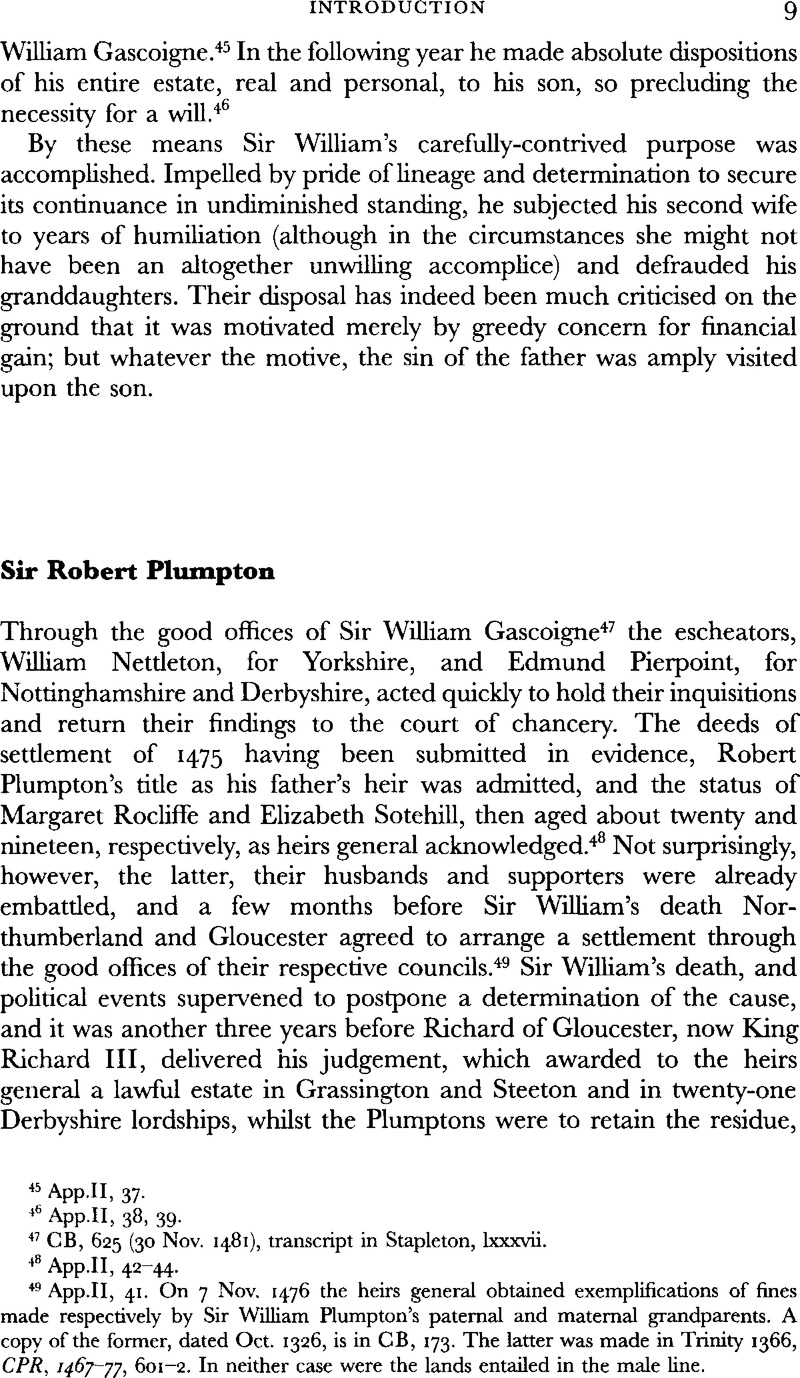No CrossRef data available.
Article contents
Sir Robert Plumpton
Published online by Cambridge University Press: 13 October 2009
Abstract

- Type
- Introduction
- Information
- Copyright
- Copyright © Royal Historical Society 1996
References
47 CB, 625 (30 Nov. 1481), transcript in Stapleton, , lxxxvii.Google Scholar
48 App.II, 42–44.
49 App.II, 41. On 7 Nov. 1476 the heirs general obtained exemplifications of fines made respectively by Sir William Plumpton's paternal and maternal grandparents. A copy of the former, dated Oct. 1326, is in CB, 173. The latter was made in Trinity 1366, CPR, 1467–77, 601–2Google Scholar. In neither case were the lands entailed in the male line.
50 App.II, 48. The original document, with the king's sign manual and the seal of the privy signet (now missing) is preserved among the Hastings MSS, Historical Manuscripts Commission, Series 78 (4 vols, 1928–1947), i, 283Google Scholar, transcripts in Horrox, R. and Hammond, P.W. (eds), British Library Harleian Manuscript 433 (Richard III Society, 4 vols, 1979–1983), iii, 133–6Google Scholar; Smith, R.B., Land and Politics in the England of Henry VIII: The West Riding of Yorkshire: 1530–46 (Oxford, 1970), 292.Google Scholar
51 Hicks, M.A., ‘Dynastic Change and Northern Society: the Career of the Fourth Earl of Northumberland, 1470–89’, NH, xiv (1978), 107.Google Scholar
52 52; Given-Wilson, , Nobility, 101.Google Scholar
53 47; DNB; Leland, John, De Rebus Britannicis Collectanea, ed. Thomas Hearne (6 vols, 1874), iv, 185–7, 229–33.Google Scholar
54 Hicks, M.A., ‘The Yorkshire Rebellion of 1489 Reconsidered’, NH, XXII(1986), 39–42Google Scholar; 74; Skelton, John, Complete English Poems, ed. VJ. Scattergood (1983), 31.Google Scholar
55 107.
56 119.
57 CPR, 1494–1509, 291Google Scholar; Ives, E.W., The Common Lawyers of Pre-Reformation England, Thomas Kebell: A Case Study (Cambridge, 1983), 311–12CrossRefGoogle Scholar; App. II, 61. For Thomas Strey, see 181. For a note on nisi prius, see 136, n. 9.
58 Sergeants John Yaxley and Thomas Frowyk, with Richard or John Brook and Gregory Edgar as counsel, 152. Frowyk was unable to appear because of his appointment as CJCP, 153, 165. For Yaxley's retainer, see App. II, 60, transcript in Stapleton, , 152–3.Google Scholar
59 152, 156–7, 159. Sir Humphrey Coningsby was one of Henry VII's feoffees, Somerville, , i, 276 n.Google Scholar
60 He obtained the support of the influential Sir Henry Willoughby, whom he subsequently rewarded with a fee, Cameron, A., ‘Sir Henry Willoughby of Wollaton’, Transactions of the Thornton Society, lxxiv (1970), 17Google Scholar; Idem, ‘A Nottinghamshire Quarrel in the Reign of Henry VII’, BIHR, xlv (1972), 29–30Google Scholar; 206.
61 Condon, M., ‘Ruling Élites in the Reign of Henry VII’, in Charles Ross (ed.), Patronage, Pedigree and Power in Later Medieval England (1979), 118Google Scholar; Bush, M.L., ‘The Problem of the Far North: A Study of the Crisis of 1537 and its Consequences’, NH, vi (1971), 42.Google Scholar
62 162, 188, 200. His son was also critical, 176.
63 L&P, I (i), 207Google Scholar; 186.
64 CB, 836; 196n Their imprisonment lasted from 24 April to 5 Aug. 1510, Stapleton, , cxviii.Google Scholar
65 210–11.
66 209; App. II, 74.
67 App.II, 75–77, 79, 80. The midlands estates became the property of the descendants of the co-heiresses, and were held in undivided moieties. The Rocliffe moiety descended through the marriage of the heiress Anne Rocliffe to Sir Ingram Clifford, through whom it came ultimately to the earls of Cumberland, and the Sotehill moiety through Henry Sotehill's twin daughters Joan and Elizabeth to Sir John Constable and SirDrury, William, Meredith, R., ‘The Eyres of Hassop, 1470–1640’, Derbyshire Archaeological Journal, lxxxv (1964), 12, 83Google Scholar; see App.I, 8.
68 66, 78, 128. He appears to have lost the office by 10 Nov. 1505 when it was granted to Thomas Fairfax of Finningley during pleasure, Somerville, , i, 524.Google Scholar
69 106, 108.
70 App.II, 78, transcript in Stapleton, , cxxiii–xxv.Google Scholar




